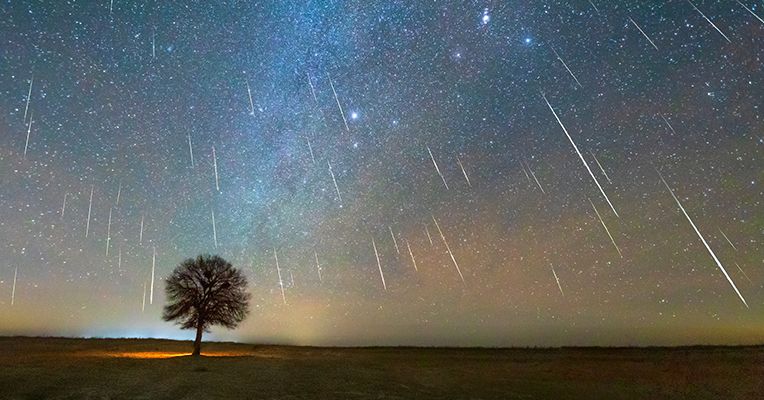
Though the Leonids produce fewer meteors than many different of the most important meteor showers, they’re recognized for producing fast-moving, shiny, fireball meteors.
The Leonids peak simply earlier than the brand new moon—on the morning of November 18, the moon can be simply 6 p.c illuminated and within the jap US received’t rise till round 5 am on November 17, so that you’ll have ample time to see this meteor bathe underneath good viewing situations.
The Leonids’ radiant is the constellation Leo, which rises round midnight native time and is highest within the sky round daybreak.
The Geminids (December)
The Geminids are energetic from about December 4 to December 17, peaking in a single day from December 13 to December 14. They’ve a pointy peak, so the evening of the thirteenth is the very best time for skywatching.
The Geminids are probably the most spectacular meteor bathe of the 12 months: Along with boasting as much as 120 and even 150 meteors per hour throughout its peak, this meteor bathe can also be the brightest and most colourful of the 12 months.
The Geminids are shiny, slow-moving meteors that usually have yellow tones, however they could be a vary of different colours, together with inexperienced, blue, white, pink, or orange. And in contrast to most meteors, that are attributable to comet particles, the Geminids are the remnant of an asteroid.
The evening that the Geminids’ peak, the their radiant, the constellation Gemini, can be above the horizon all evening and can attain its highest level round 2 am native time, so meteors can be seen nearly the entire evening.
That very same evening, the moon can be about 32 p.c illuminated and can rise round 1:30 am within the jap US, so if you happen to watch this bathe shortly after midnight, the moonlight received’t intrude along with your viewing expertise.
The Ursids (December)
The Ursids are energetic round December 17 to December 26, peaking within the early morning hours of December 22. This meteor bathe is much less energetic than others, usually yields about 10 meteors per hour; nevertheless, viewing situations can be good for skywatching. The moon will set at roughly 6 pm within the jap US on the twenty first, so no moonlight will intrude with this meteor bathe.
Though the Ursids usually produce probably the most meteors simply earlier than daybreak, when its radiant, the Little Dipper (or Ursa Minor), is highest within the sky, it is possible for you to to see meteors all through your entire evening throughout this bathe’s peak. In northern latitudes the Ursids’ radiant is above the horizon all evening.
Showers to Look Out for Subsequent 12 months
The Quadrantids (January)
The Quadrantids happen in December and January and peak throughout the first week of the 12 months. This meteor bathe has a pointy peak, that means that the majority of its exercise happens in a slender window of time. The Quadrantids usually produce many fireball meteors—that’s, meteors which are very shiny—with as much as 120 meteors per hour throughout the bathe’s peak.
The Quadrantids’ radiant is the constellation Quadrans Muralis, although the Worldwide Astronomical Union not acknowledges this group of stars as a constellation. As a substitute is the constellation Boötes, which is subsequent to the Massive Dipper.





